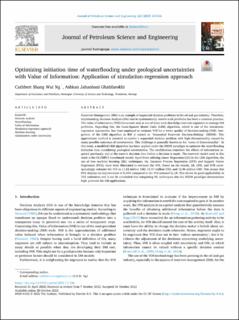| dc.contributor.author | Ng, Cuthbert Shang Wui | |
| dc.contributor.author | Jahanbani Ghahfarokhi, Ashkan | |
| dc.date.accessioned | 2023-01-31T11:21:33Z | |
| dc.date.available | 2023-01-31T11:21:33Z | |
| dc.date.created | 2022-10-31T16:30:08Z | |
| dc.date.issued | 2022 | |
| dc.identifier.citation | Journal of Petroleum Science and Engineering. 2022, 220 (A), . | en_US |
| dc.identifier.issn | 0920-4105 | |
| dc.identifier.uri | https://hdl.handle.net/11250/3047359 | |
| dc.description.abstract | Reservoir Management (RM) is an example of sequential decision problems in the oil and gas industry. Therefore, implementing Decision Analysis (DA) tool to systematically resolve such problems has been a common practice. The value of Information (VOI) framework acts as one of these tools that helps reservoir engineers to manage RM problems. Regarding this, the Least-Squares Monte Carlo (LSM) algorithm, which is one of the simulation-regression approaches, has been employed to estimate VOI for a better quality of decision-making (DM). Integration of the LSM algorithm in RM is coined as “Sequential Reservoir Decision-Making” (SRDM). This approximate method is essential to resolve a sequential decision problem with high dimensionality caused by many possible outcomes of uncertainties. This challenge is generally known as the “curse of dimensionality”. In this work, a modified LSM algorithm has been applied under the SRDM paradigm to optimize the waterflooding initiation time considering geological uncertainties. The modification considers the effects of information acquired previously and at the current decision time before a decision is made. The reservoir model used in this work is the OLYMPUS benchmark model. Apart from utilizing Linear Regression (LR) in the LSM algorithm, the use of two machine learning (ML) techniques, viz. Gaussian Process Regression (GPR) and Support Vector Regression (SVR), have been illustrated to estimate the VOI. Based on the results, LR, GPR, and SVR correspondingly estimate the VOI as 11.52 million USD, 11.17 million USD, and 12.46 million USD. This means that SVR displays an improvement of 8.18% compared to the VOI assessed by LR. This shows its good applicability in VOI estimation and it can be concluded that integrating ML techniques into the SRDM paradigm demonstrates high potential for RM applications. | en_US |
| dc.language.iso | eng | en_US |
| dc.publisher | Elsevier | en_US |
| dc.rights | Navngivelse 4.0 Internasjonal | * |
| dc.rights.uri | http://creativecommons.org/licenses/by/4.0/deed.no | * |
| dc.title | Optimizing initiation time of waterflooding under geological uncertainties with Value of Information: Application of simulation-regression approach | en_US |
| dc.title.alternative | Optimizing initiation time of waterflooding under geological uncertainties with Value of Information: Application of simulation-regression approach | en_US |
| dc.type | Peer reviewed | en_US |
| dc.type | Journal article | en_US |
| dc.description.version | publishedVersion | en_US |
| dc.source.pagenumber | 12 | en_US |
| dc.source.volume | 220 | en_US |
| dc.source.journal | Journal of Petroleum Science and Engineering | en_US |
| dc.source.issue | A | en_US |
| dc.identifier.doi | 10.1016/j.petrol.2022.111166 | |
| dc.identifier.cristin | 2067010 | |
| cristin.ispublished | true | |
| cristin.fulltext | postprint | |
| cristin.fulltext | original | |
| cristin.qualitycode | 2 | |

